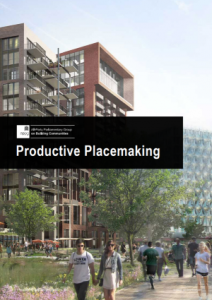 The All-Party Parliamentary Group(APPG) on Building Communities published the ‘Productive Placemaking Report ‘on the 22 September.
The All-Party Parliamentary Group(APPG) on Building Communities published the ‘Productive Placemaking Report ‘on the 22 September.
…need to work harder to make normal activities pleasurable, safe and healthy…
… report has a number of great examples of good design and stewardship…
The APPG on Building Communities writes:
To combat these feelings of loneliness and isolation, we will need to work harder to make normal activities pleasurable, safe and healthy and, where possible, re-think our development models to ensure that people are able to go shopping, spend time in nature or to see a doctor within a 10-15 minute walk from home. We will need see developers and planners push for a better use for space – we can no longer just fill in unused spaces with car parks – we need bike racks, children’s playgrounds, nature trails, outdoor gyms, community allotments, and more
This report has a number of great examples of good design and stewardship which promotes good mental and physical health and produces positive and productive places. We must not forget that these are also fundamentally important to delivering community, which will be the best way to ensure our villages, towns and cities are resilient to the effects of the exceptional times we are living through and that they will flourish in the years and decades to come….
Our recommendations are:
- MHCLG should incorporate placemaking at the heart of the text of the National Planning Policy Framework (NPPF).
- Local industrial strategies should incentives developers to share best practice in terms of community engagement on major projects, as a driver of productivity.
- Financial and policy structures need to be in place to secure a productive development strategy and to ensure long-term management of a place.
- ONS must recognise and develop a measurement of placemaking and its link to productivity of a community and/or contribution to GDP.
- The UK Government should aim to reduce the cost of land for the creation of affordable housing.
- Replace the Community Infrastructure Levy (CIL) with a new Property Sales Levy.
For more background see the website

